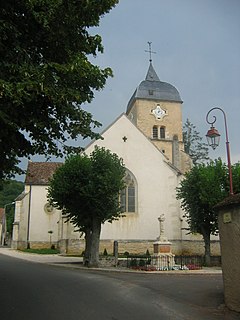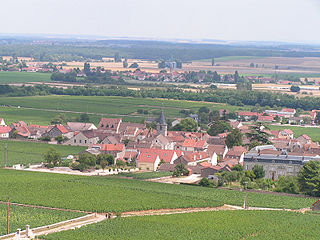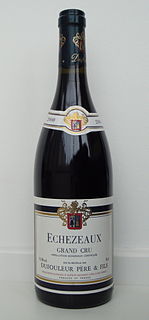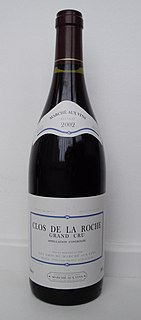
Burgundy wine is wine made in the Burgundy region in eastern France, in the valleys and slopes west of the Saône, a tributary of the Rhône. The most famous wines produced here—those commonly referred to as "Burgundies"—are dry red wines made from pinot noir grapes and white wines made from chardonnay grapes.

Banyuls is a French appellation d'origine contrôlée (AOC) for a fortified apéritif or dessert wine made from old vines cultivated in terraces on the slopes of the Catalan Pyrenees in the Roussillon county of France, bordering, to the south, the Empordà wine region in Catalonia in Spain.

Chambertin is an Appellation d'origine contrôlée (AOC) and Grand Cru vineyard for red wine in the Côte de Nuits subregion of Burgundy, with Pinot noir as the main grape variety. Chambertin is located within the commune of Gevrey-Chambertin, and it is situated approximately in the centre of a group of nine Grand Cru vineyards all having "Chambertin" as part of their name. The other eight vineyards, which all are separate AOCs, have hyphenated names where Chambertin appears together with something else, such as Chapelle-Chambertin. Chambertin itself is situated above the Route des Grands Crus. It borders on Chambertin-Clos de Bèze in the north, Griotte-Chambertin and Charmes-Chambertin in the east and the Latricières-Chambertin in the south. The AOC was created in 1937.

Chambolle-Musigny is a commune in the Côte-d'Or département in eastern France.

Vosne-Romanée is a commune in the Côte-d'Or department in Burgundy in eastern France.

Montrachet is an Appellation d'origine contrôlée (AOC) and Grand Cru vineyard for white wine made of Chardonnay in the Côte de Beaune subregion of Burgundy. It straddles the border between the two communes of Chassagne-Montrachet and Puligny-Montrachet and produces what many consider to be the greatest dry white wine in the world. It is surrounded by four other Grand Cru vineyards all having "Montrachet" as part of their names. Montrachet itself is generally considered superior to its four Grand Cru neighbours, and this is reflected in its higher price.
Domaine Leflaive is a winery in Puligny-Montrachet, Côte de Beaune, Burgundy. The domaine is very highly regarded for its white wines, and its vineyard holdings include 5.1 hectares of Grand Cru vineyards.

Romanée-Saint-Vivant is an Appellation d'origine contrôlée (AOC) and Grand Cru vineyard for red wine in the Côte de Nuits subregion of Burgundy, with Pinot noir as the main grape variety. It is situated within the commune of Vosne-Romanée. La Romanée borders on La Grande Rue in the south, Romanée-Conti and Richebourg in the west, Vosne-Romanée Premier Cru vineyards in the north and in the east and also the village Vosne-Romanée itself in the east. The AOC was created in 1936. It takes its name from the Abbey of Saint Vivant, which in Medieval times owned several vineyards among the Vosne-Romanée Grands Crus.

Échezeaux is an Appellation d'origine contrôlée (AOC) and Grand Cru vineyard for red wine in the Côte de Nuits subregion of Burgundy, with Pinot noir as the main grape variety. Échezeaux is located within the commune of Flagey-Echézeaux, on a strip of land between the territory of the communes Vosne-Romanée, Vougeot and Chambolle-Musigny. Échezeaux borders on the Clos de Vougeot and its wall as well as Grands Échezeaux in the east, on Chambolle-Musigny vineyards in the north, some Vosne-Romanée vineyards in the west and on the Vosne-Romanée Premier Cru vineyard Les Suchots in the south. The AOC was created in 1937.

Richebourg is an Appellation d'origine contrôlée (AOC) and Grand Cru vineyard for red wine in the Côte de Nuits subregion of Burgundy, with Pinot noir as the main grape variety. It is situated within the commune of Vosne-Romanée, and borders La Romanée and Romanée-Conti in the south, Romanée-Saint-Vivant in the east and Vosne-Romanée Premier Cru vineyards in the north and west. The AOC was created in 1936.

Clos de la Roche is an Appellation d'origine contrôlée for red wine in the Côte de Nuits subregion of Burgundy, with Pinot noir as the main grape variety. It is situated in the commune of Morey-Saint-Denis in the Côte-d'Or département. Clos de la Roche is located in the northern part of the commune, stretches to the border of Gevrey-Chambertin, and borders to the Grand Cru vineyard Clos Saint-Denis in the south. It borders the Route des Grands Crus in the east. The AOC was created in 1936, and the Clos part of its name refers to a wall-enclosed vineyard.

Clos des Lambrays is an Appellation d'origine contrôlée (AOC) and Grand Cru vineyard for red wine in the Côte de Nuits subregion of Burgundy, with Pinot noir as the main grape variety. It is situated in the commune of Morey-Saint-Denis in the Côte-d'Or département, and is located immediately to the southwest of the village Morey-Saint-Denis. The Clos part of its name refers to a wall-enclosed vineyard. Clos des Lambrays was elevated from premier cru to grand cru status in 1981, which meant that it was created as a separate AOC.

Clos de Tart is an Appellation d'origine contrôlée (AOC) and Grand Cru vineyard for red wine in the Côte de Nuits subregion of Burgundy, with Pinot noir as the main grape variety. It is situated in the commune of Morey-Saint-Denis in the Côte-d'Or département. Clos de Tart is located in the southern part of the commune, starts immediately west (uphill) of the village itself, and borders to the Grand Cru vineyard Bonnes Mares in the south and Clos des Lambrays in the north. The AOC was created in 1939, and the Clos part of its name refers to a wall-enclosed vineyard.
Musigny, sometimes referred to as Le Musigny, is an Appellation d'origine contrôlée (AOC) and Grand Cru vineyard for red and white wine in Côte de Nuits of Burgundy. It is located within the commune of Chambolle-Musigny, to the south of the village itself. It borders on the Grand Cru Clos de Vougeot in the southeast, the Grand Cru Échezeaux in the south, and the Premier Cru Les Amoureuses in the northeast. The name is derived from a family de Musigny which is now extinct, but which held offices in the court of the Dukes of Burgundy from the 14th century. The AOC was created in 1936, but the borders of Musigny were previously set down legally in 1929.

Grands Échezeaux is an Appellation d'origine contrôlée (AOC) and Grand Cru vineyard for red wine in the Côte de Nuits subregion of Burgundy, with Pinot noir as the main grape variety. Grands Échezeaux is located within the commune of Flagey-Echézeaux, on a strip of land between the territory of the communes Vosne-Romanée, Vougeot and Chambolle-Musigny. Grands Échezeaux borders on Clos de Vougeot and its wall in the east and north, and on Échezeaux in the west and south. The AOC was created in 1936.
Maison Louis Latour is an important négociant-éléveur of red and white wines in Burgundy, France. Currently run by the seventh Louis Latour, Louis-Fabrice Latour, the company has remained family-run since its foundation in 1797 and has built a reputation for tradition and innovation. This Domaine has the largest Grand Cru property in the Cote d'Or with a total of 28.63 hectares. In 1997 Louis Latour was admitted into the exclusive club of the Hénokiens. This club only admits companies that remain family owned, have a history of 200 years' experience and still bears the name of the founder.

The wine region of Alsace produces wines under three different Appellations d'Origine Contrôlées (AOCs): Alsace AOC for white, rosé and red wines, Alsace Grand Cru AOC for white wines from certain classified vineyards and Crémant d'Alsace AOC for sparkling wines. This region is the only French wine region allowed to label its wines based on variety.

La Tâche is an Appellation d'origine contrôlée (AOC) and Grand Cru vineyard for red wine in the Côte de Nuits subregion of Burgundy, with Pinot noir as the main grape variety. It is situated within the commune of Vosne-Romanée and is a monopole of the winery Domaine de la Romanée-Conti. La Tâche borders on La Grande Rue in the north, and mostly on Vosne-Romanée Premier Cru vineyards in the east, south and west. The AOC was created in 1936.

Vosne-Romanée wine is produced in the commune of Vosne-Romanée in Côte de Nuits of Burgundy as well as in the neighbouring commune of Flagey-Échezeaux. The Appellation d'origine contrôlée (AOC) Vosne-Romanée may only be used for red wine with Pinot noir as the main grape. There are a total of 15 Premier Cru vineyards in the two communes, as well as six Grand Cru vineyards in Vosne-Romanée and two in Flagey-Échezeaux. These Grand Cru vineyards include Burgundy's most iconic, sought-after and expensive red wines, with Romanée-Conti of Domaine de la Romanée-Conti at the pinnacle: "There can be little doubt that in the firmament of the Cote de nuits, Vosne-Romanée is the brightest star."

Domaine de la Romanée-Conti, often abbreviated to DRC, is an estate in Burgundy, France that produces white and red wine. It is widely considered among the world's greatest wine producers, and DRC bottles are among the world's most expensive. It takes its name from the domaine's most famous vineyard, Romanée-Conti.
















